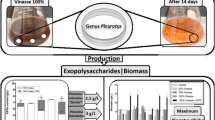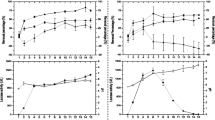Abstract
Raw vine-trimming wastes or the solid residues obtained after different fractionation treatments were evaluated for their suitability as Amycolatopsis sp. immobilization carriers during the bioconversion of ferulic acid into valuable phenolic compounds such as vanillin, vanillyl alcohol, and vanillic acid, the main flavor components of vanilla pods. Previously, physical–chemical characteristics of the materials were determined by quantitative acid hydrolysis and water absorption index (WAI), and microbiological characteristics by calculating the cell retention in the carrier (λ). Additionally, micrographics of carrier surface were obtained by field emission-scanning electron microscopy to study the influence of morphological changes during pretreatments in the adhesion of cells immobilized. The results point out that in spite of showing the lowest WAI and intermediate λ, raw material was the most appropriated substrate to conduct the bioconversion, achieving up to 262.9 mg/L phenolic compounds after 24 h, corresponding to 42.9 mg/L vanillin, 115.6 mg/L vanillyl alcohol, and 104.4 mg/L vanillic acid. The results showed the potential of this process to be applied for biotechnological production of vanillin from ferulic acid solutions; however, further studies must be carried out to increase vanillin yield. Additionally, the liquors obtained after treatment of vine-trimming wastes could be assayed to replace synthetic ferulic acid.



Similar content being viewed by others
References
Anderson RA, Conway HF, Pfeifer VF, Griffin E (1969) Gelatinization of corn grits by roll and extrusion cooking. Cereal Sci Today 14:11–12
Bustos G, Moldes AB, Cruz JM, Domínguez JM (2004) Production of fermentable media from trimming wastes and bioconversion into lactic acid by Lactobacillus pentosus. J Sci Food Agric 84:2105–2112
Converti A, Aliakbarian B, Domínguez JM, Bustos Vázquez G, Perego P (2010) MICROBIAL production of biovanillin. Braz J Microbiol 41:519–530
Domínguez JM, Salgado JM, Rodríguez N, Cortés S (2012) Biotechnological production of xylitol from agro-industrial wastes. In: El-Samragy Y (ed) Food additive. Intech, Rijeka, pp 139–156
Fleige C, Hansen G, Kroll J, Steinbüchel A (2013) Investigation of the Amycolatopsis sp. strain ATCC 39116 vanillin dehydrogenase and its impact on the biotechnical production of vanillin. Appl Environ Microbiol 79:81–90
Hendriks ATWM, Zeeman G (2009) Pretreatments to enhance the digestibility of lignocellulosic biomass. Biores Technol 100:10–18
Kasana RC, Sharma UK, Sharma N, Sinha AK (2007) Isolation and identification of a novel strain of Pseudomonas chlororaphis capable of transforming isoeugenol to vanillin. Curr Microbiol 54:457–461
Li X, Yang J, Li X, Gu W, Huang J, Zhang KQ (2008) The metabolism of ferulic acid via 4-vinylguaiacol to vanillin by Enterobacter sp. Px6–4 isolated from Vanilla root. Process Biochem 43:1132–1137
Max B, Salgado JM, Cortés S, Domínguez JM (2010) Extraction of phenolic acids by alkaline hydrolysis from the solid residue obtained after prehydrolysis of trimming vine shoots. J Agric Food Chem 58:1909–1917
Muheim A, Lerch K (1999) Towards a high-yield bioconversion of ferulic acid to vanillin. Appl Microbiol Biotechnol 51:456–461
Orzua MC, Mussatto SI, Contreras-Esquivel JC, Rodríguez R, de la Garza H, Teixeira JA, Aguilar CN (2009) Exploitation of agro industrial wastes as immobilization carrier for solid-state fermentation. Ind Crop Prod 30:24–27
Pérez-Rodríguez N, Oliveira F, Pérez-Bibbins B, Belo I, Torrado Agrasar A, Domínguez JM (2014) Optimization of xylanase production by filamentous fungi in solid-state fermentation and scale-up to horizontal tube bioreactor. Appl Biochem Biotechnol 173:803–825
Pérez-Rodríguez N, de Souza Pinheiro, Oliveira R, Torrado Agrasar AM, Domínguez JM (2016) Ferulic acid transformation into the main vanilla aroma compounds by Amycolatopsis sp. ATCC 39116. Appl Microbiol Biotechnol 100:1677–1689
Priefert H, Rabenhorst J, Steinbüchel A (2001) Biotechnological production of vanillin. Appl Microbiol Biotechnol 56:296–314
Raghavarao KS, Ramganathan TV, Karanth NG (2003) Some engineering aspects of solid-state fermentation. Biochem Eng J 13:127–135
Robledo A, Aguilera-Carbó A, Rodríguez R, Martínez JL, Garza Y, Aguilar CN (2008) Ellagic acid production by Aspergillus niger in solid state fermentation of pomegranate residues. J Ind Microbiol Biotechnol 35:507–513
Rosazza JPN, Huang Z, Dostal L, Volm T, Rousseau B (1995) Biocatalytic transformations of ferulic acid: an abundant aromatic natural product. J Ind Microbiol 15:457–471
Silva SS, Mussato SI, Santos LC, Santos DT, Polizel J (2007) Cell immobilization and xylitol production using sugarcane bagasse as raw material. Appl Biochem Biotechnol 141:215–228
Sova M (2012) Antioxidant and antimicrobial activities of cinnamic acid derivatives. Mini Rev Med Chem 12:749–767
Acknowledgments
We thank the Spanish Ministry of Economy and Competitiveness for the financial support of this work (project CTQ2015-71436-C2-1-R), which has partial financial support from the FEDER funds of the European Union; the Spanish Ministry of Education, Culture and Sports for Pérez-Rodríguez‘s FPU; and CAPES (Coordination of High-Level Personnel Training, Brazil) for Prof. J. M. Domínguez fellowship as Special Visiting Researcher (Science without Borders Program, project n. 88881.062223/2014-01). Authors also thank the Mexican National Council for Science and Technology (CONACYT) for financial support to M.Sc. Juan Francisco Castañón Rodríguez for his research stay in Spain.
Author information
Authors and Affiliations
Corresponding author
Ethics declarations
Conflict of Interest
The authors declare that they have no conflict of interest.
Human and Animal Rights and Informed Consent
This article does not contain any studies with human or animal subjects.
Rights and permissions
About this article
Cite this article
Castañón-Rodríguez, J.F., Pérez-Rodríguez, N., de Souza Oliveira, R.P. et al. Use of Vine-Trimming Wastes as Carrier for Amycolatopsis sp. to Produce Vanillin, Vanillyl Alcohol, and Vanillic Acid. Curr Microbiol 73, 561–568 (2016). https://doi.org/10.1007/s00284-016-1094-9
Received:
Accepted:
Published:
Issue Date:
DOI: https://doi.org/10.1007/s00284-016-1094-9




